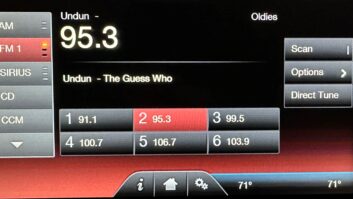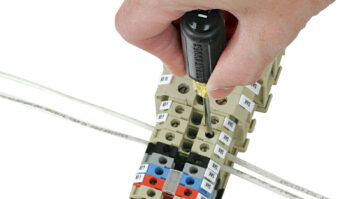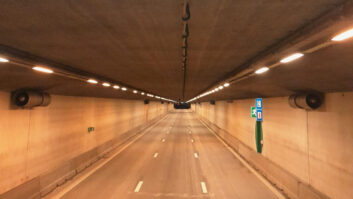Ever have one of those days? How about when “one of those days” for six months straight?
Those of us at WAWZ(FM) in Zarephath, N.J., were having “one of those days” in August last year as we prepared to meet “that nasty girl,” as General Manager Rea Crawford calls her: Hurricane Irene. She was headed straight for the town, which has been home to our Christian radio station since 1931.

A view of Irene’s work at the Zarephath campus.
By the time it got to us it would be weakened to tropical storm level, but we were bracing for more than just a little wind and rain. Zarephath is only 60 feet above sea level, bordered to the north by the Millstone River and to the south by the Delaware River and Raritan Canal.
Sure enough, by the time Irene was finished with us, Zarephath and the surrounding area — a campus that includes several other Pillar of Fire International ministries besides WAWZ(FM), as well as the Zarephath Christian Church and Somerset Christian College — were under almost eight feet of water.
The good news was that the residents had been evacuated. The bad news was that property damage was extensive.
WAWZ’s studios were on the second floor of a chapel building; we were spared the worst of the damage. The only casualty in terms of station equipment was our studio generator. Amazingly, the studios never lost power during the storm, despite the fact that the main distribution panel for the building was under water.
The Bunker earns its keep
To prevent the water damage from becoming mold damage, the first floor of every building on the campus eventually would have to be gutted. Hardwood floors would be uprooted and drywall and plaster removed, leaving the muddy campus looking like a war zone. The resulting pile of debris would dwarf most houses. Then there was the inevitable stench of muddy river sludge and mildew, making all but the heartiest unable to linger more than a few hours at a time.
So how did we continue broadcasting?

Midday Host Betsy Spina in ‘The Bunker’
Fortunately, WAWZ has a fully functional backup studio at our transmitter site in Martinsville, N.J., 600 feet above sea level. We lovingly refer to this windowless slab of concrete behind our transmitter building as “The Bunker.” After all, that’s sort of what it was: a refuge and haven.
This was not the first time our facilities had been flooded. For decades Zarephath would flood with severe weather, most notably Hurricane Floyd in 1999, which caused as much damage as Irene.
After a particularly unforgiving Nor’easter in 2006 — one that flooded the basements and parking lot, and turned the adjoining Weston Canal Road into plain old Weston Canal — station management had decided something needed to be done to avoid broadcast interruption.
So in 2008 we looked at a 7-by-18-foot storage room attached to the back of our transmitter building that had housed paging transmitters during that industry’s heyday. As it happened, we’d been planning to remodel our main studio and would need temporary facilities anyway. We decided to build the new backup studio. This met the need for a temporary studio in the short term and would provide an emergency facility from then on (see “Renovations Bring WAWZ Into the 21st Century,” Radio World, Oct. 8, 2008).
Years later, in the aftermath of Irene, The Bunker would earn its keep. We moved on-air operations there the night before the storm arrived in Somerset County, carrying a few pieces of production gear with us, and not knowing when we’d be allowed back at home base.

A listener volunteered this travel trailer to help provide space.
While this kept us on the air and gave us rudimentary production capabilities, it soon became clear that we needed more space. Thankfully, one of our listeners stepped up with a 30-foot travel trailer that he towed to our site and let Chief Engineer Ron Habegger and I equip with electrical and Internet service.
Once we were allowed back on campus, we collected a couple of production workstations and turned the RV into a production studio, complete with a kitchen and indoor bathroom — a major step up from the Port-a-John we had been using.
There’s no place like home
Our home base at Zarephath continued to stink of mildew, diesel fuel and who knows what else.
On top of that, the mold abatement work had left everything covered in dust. Plus, it wasn’t a question of if we’d ever get flooded again, but when. So now management reconsidered whether to move back.
We moved the studios off-campus again and began looking for available rental space. In the meantime, the second floor was given a good cleaning.
In November 2011, three months after the storm, we resumed broadcasting and production from Zarephath, with staff working across the street at the Children’s Ministry Center. (The sales staff worked mostly from home, and the station manager worked from any Starbucks with Wi-Fi.)

Tom Bruemmer, Ron Habegger and Curt Yengst install furniture
Sadly, negotiations weren’t going well with prospective new landlords. Building a radio station in an existing office space is sometimes easier said than done, especially when you’re trying to explain your specific needs (“You want to put a window where?” “Why does that corner office need to be soundproof?”).
Following some particularly disappointing meetings, our management team was at a loss. We are Christian broadcasters, after all, so we decided to hold a quick, impromptu prayer meeting; then we adjourned for the day.
As Rea Crawford was driving away from the prayer meeting, he happened to pass a local industrial development in neighboring Somerset, and glanced at the large office buildings there. He came upon the headquarters of Village Office Supply and he noticed that the Supply’s parking lot didn’t look very full for a building of its size. So he pulled in, entered the lobby and asked if they had any office space for rent.
Turns out, Village Office Supply had laid off about 50 employees two years earlier, and they hadn’t yet decided what to do with the space. They’d considered renting it but were reluctant to deal with brokers, lawyers, etc.; but when we presented our situation, they decided to open their doors to us, allowing us to do whatever we needed to create the space we wanted. They even loaned us a couple of their delivery trucks for the move. It was a match made in heaven!

Johnny Stone and the morning crew work in the new studio.
In January 2012, we signed the lease and construction began. On the week of Valentine’s Day, we sent on-air staff back to that ever-romantic Bunker for a couple weeks, while Ron and I dismantled the old studio and, with the help of volunteers, painstakingly reconnected everything in our new studio, which is almost twice the size of the old one.
At last, after a labor-intensive several days, we began broadcasting from the new studios on Feb. 23 — without a hitch.
Since that successful first broadcast in our new temporary home, we’ve made plans to construct a building specifically for the radio station that will be more permanent. And we’ve started a capital campaign to raise necessary funds. Meanwhile, after spending the last half-dozen months working from as many different locations, it’s great to finally be back together again as one big, happy broadcast family.
Curt Yengst CSRE, is assistant engineer at WAWZ(FM). For more on the history of the station, see the story “Rea Crawford Hits a Milestone” at radioworld.com, keyword WAWZ.
Thanks to Rea Crawford, LuAnn Schafer, Stacey Stone, Ron Habegger and David A. Dein for photo contributions.












